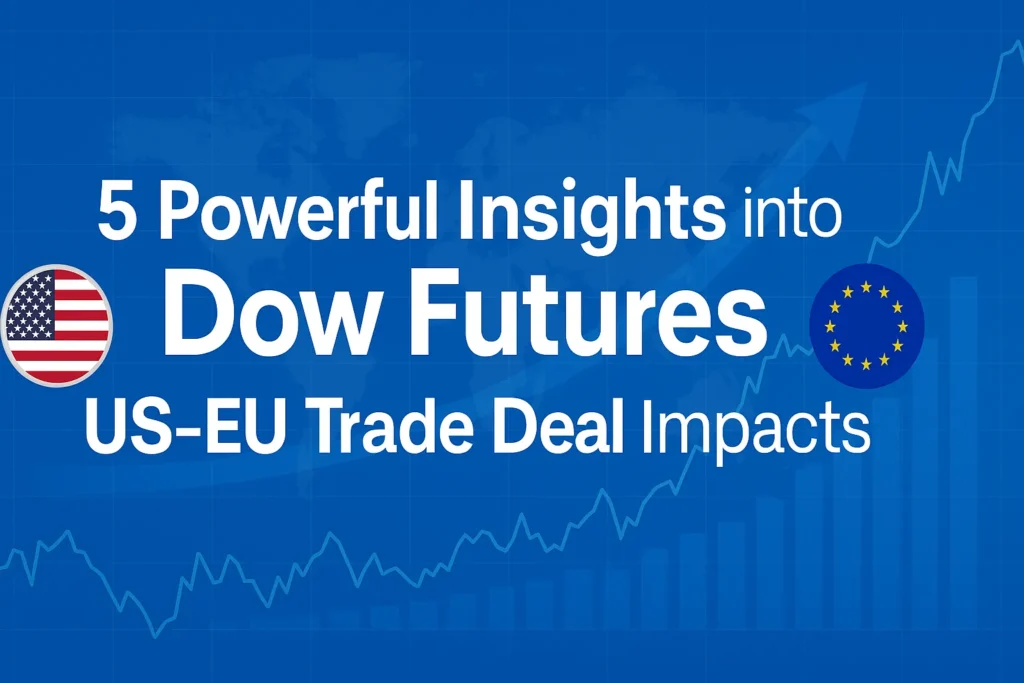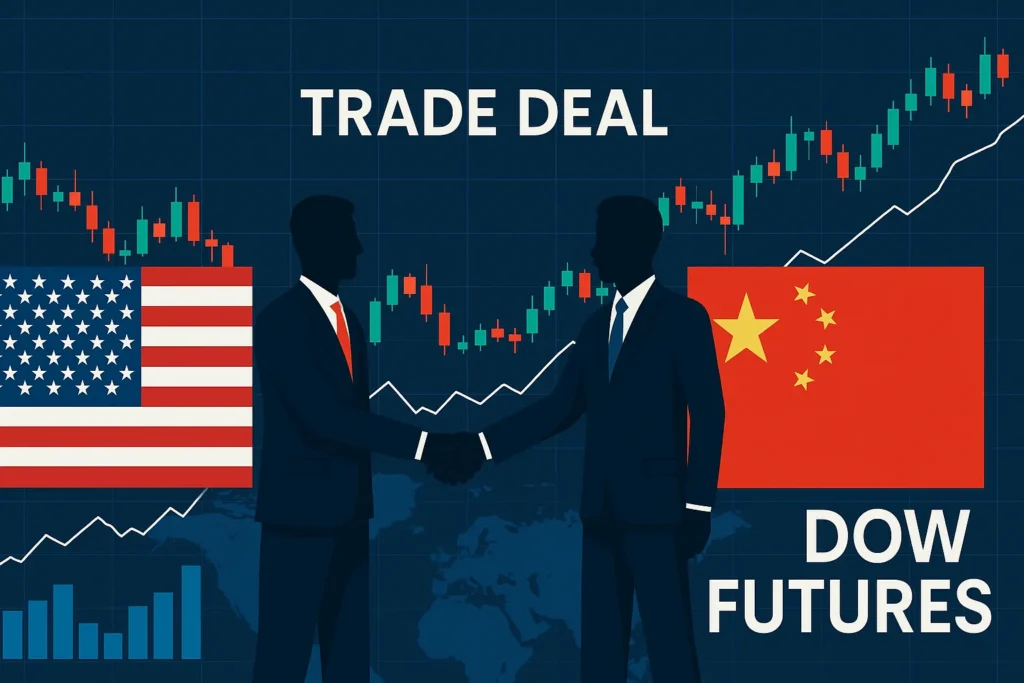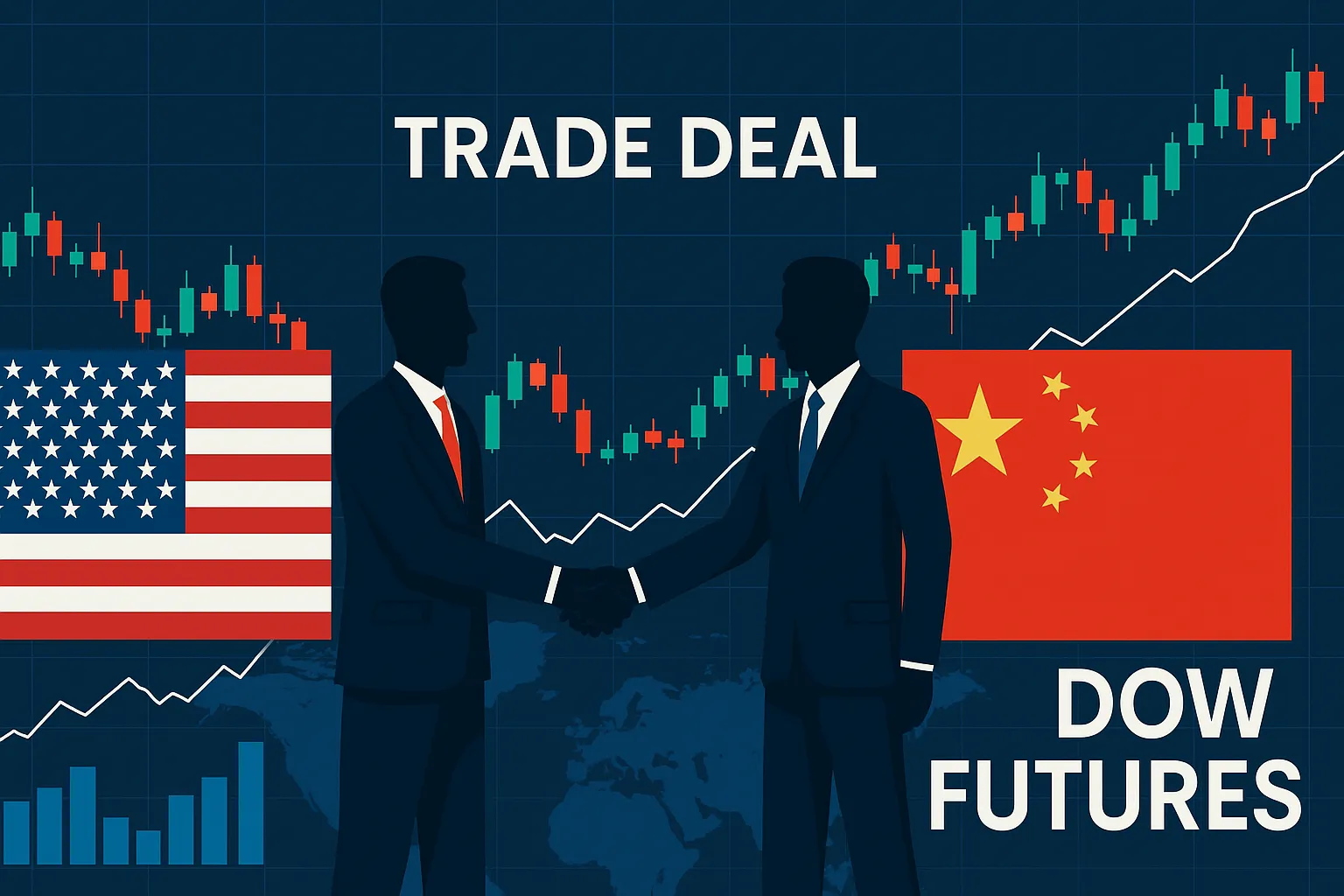Introduction:
What Are Dow Futures and Why the US-EU Trade Deal Matters
The financial world never sleeps. Among its most watched indicators are Dow Futures, which serve as an early measure of market sentiment before the opening bell rings on Wall Street. These financial contracts offer a glimpse into how traders expect the market to perform based on recent events, economic data, and political developments. When a major international policy shift—like the recent US-EU Trade Deal—enters the picture, it carries the potential to dramatically sway global markets.
This comprehensive guide explores the nuances of Dow Futures, how the US-EU Trade Deal is shaping investor behavior, and what it means for traders, multinational businesses, and the broader economy in both the short and long term. You’ll also learn how this landmark agreement affects trade relationships, economic stability, and corporate growth strategies in a globalized world.

1. Understanding Dow Futures: The Basics US-EU Trade Deal
Before we analyze the ripple effects of the US-EU Trade Deal, it’s crucial to understand what Dow Futures are and how they function within the broader financial ecosystem.
Dow Futures are derivative contracts that speculate on the future value of the Dow Jones Industrial Average (DJIA), one of the oldest and most widely followed stock market indices. These contracts are used by a wide range of participants—from institutional investors to retail traders—to hedge portfolios, speculate on market direction, or begin trading before the official U.S. stock market opens.
Traded almost 24/7 on platforms like the Chicago Mercantile Exchange (CME), Dow Futures reflect market sentiment related to economic indicators, earnings reports, and geopolitical events. Because they are sensitive to breaking news, Dow Futures serve as a real-time indicator of investor confidence and market risk appetite.
Understanding how Dow Futures react to significant developments like the US-EU Trade Deal is essential for navigating today’s increasingly complex financial markets.
2. The US-EU Trade Deal: A Game-Changer in 2025
The ratification of the US-EU Trade Deal in July 2025 marked a significant milestone in global commerce. This landmark agreement redefines the economic relationship between two of the world’s largest trading blocs by reducing barriers and encouraging cross-border innovation.
Coming at a time when both economies were emerging from supply chain disruptions and inflationary pressures, the deal is designed to stimulate economic growth, reduce trade frictions, and foster deeper cooperation in sectors critical to the 21st-century economy.
Key Provisions of the US-EU Trade Deal: US-EU Trade Deal
- Tariff Removal: Immediate elimination of tariffs on key goods including steel, aluminum, auto parts, and agricultural exports.
- Digital Trade Enhancement: Mutual recognition of digital standards and cybersecurity protocols.
- Sustainable Trade Initiatives: Joint investment programs for clean energy, including wind, solar, and hydrogen.
- Streamlined Customs: Harmonized customs procedures to simplify logistics and reduce cross-border compliance hurdles.
Following the announcement, Dow Futures surged, signaling optimism about improved trade conditions, higher corporate earnings, and reduced policy uncertainty—all key factors in driving equity markets upward.

3. How the US-EU Trade Deal Influences Dow Futures
Trade agreements like the US-EU Trade Deal can significantly influence market psychology and pricing mechanisms. Here’s how this deal impacts Dow Futures in tangible ways:
i. Boost in Export-Driven Stocks
Many Dow-listed companies—such as Boeing, Honeywell, and Intel—generate substantial revenue from international markets. Reduced tariffs and aligned regulations enhance these companies’ ability to compete in Europe.
ii. Reduction in Market Uncertainty
Markets thrive on predictability. By clarifying the trade landscape, the deal minimizes future tariff risks and geopolitical tension, encouraging long-term investment.
iii. Strengthening of the U.S. Dollar
Improved trade flow often leads to a stronger U.S. dollar. While this benefits importers and investors, it may present challenges for certain exporters.
iv. Rise in Investor Confidence and Volume
In the week following the deal, trading volumes in Dow Futures rose over 30%, reflecting renewed market optimism and expectations for economic resilience.
v. Improved Corporate Forecasting
Clearer trade rules enable more accurate inventory planning, production scheduling, and capital allocation—leading to more stable financial outlooks.
4. Short-Term vs. Long-Term Impacts on Dow Futures-US-EU Trade Deal
The effects of a major trade deal unfold over time. It’s critical to distinguish between initial investor reactions and sustained economic outcomes.
Short-Term Effects:
- Increased price volatility in Dow Futures and related ETFs like DIA.
- Sector rotation into manufacturing, logistics, and technology.
- Surge in media coverage attracting retail investors.
- Heightened algorithmic and speculative trading.
Medium-Term Outlook (6–12 Months):
- Revisions in corporate earnings for multinational firms.
- Growth in capital expenditures and facility expansion.
- Increase in merger and acquisition activity driven by favorable conditions.
Long-Term Impacts:
- Elevated GDP and productivity, supporting bullish trends.
- Stronger U.S.-EU political and economic alignment.
- Upward revaluation of stocks in green energy, AI, and digital infrastructure.
Historical Context: US-EU Trade Deal
The last comparable agreement—the U.S.-China phase one deal in 2019—saw mixed results. However, the Dow Futures US-EU Trade Deal is proving more stable due to greater political harmony and transparency between the U.S. and EU.
5. What Traders and Investors Should Do Now
With the Dow Futures US-EU Trade Deal in full effect, traders and investors must adapt their strategies to capitalize on emerging opportunities.
For Day Traders:
- Track real-time news and chart signals.
- Use technical indicators to capture short-term volatility.
- Employ hedging strategies like spreads or options.
For Swing Traders:
- Focus on sector ETFs with exposure to EU-U.S. trade.
- Watch earnings guidance closely for trade-related gains.
For Long-Term Investors:
- Increase holdings in multinational firms and export-heavy sectors.
- Prioritize companies with strong transatlantic revenue streams.
- Rebalance portfolios to include dividend-paying Dow constituents.
Risk Management:
- Use stop-loss and take-profit orders.
- Stay informed with central bank updates and trade policy shifts.
- Avoid overconcentration in one sector or geography.
Broader Economic and Political Implications-US-EU Trade Deal
Beyond the financial markets, the US-EU Trade Deal represents a forward-thinking model for international collaboration. It aims to counter rising protectionism and reinforce global supply chain resilience.
For Businesses:
Companies gain clarity and cost efficiency, while small and mid-sized enterprises find it easier to access new markets under simplified trade rules.
For Policymakers:
The agreement provides a framework for future cooperation in digital governance, AI regulation, and climate policy.
For the Labor Market:
With more robust transatlantic trade, job creation in sectors like clean energy, logistics, and advanced manufacturing is expected to rise.
Conclusion: Why the Dow Futures US-EU Trade Deal Matters Now More Than Ever
In an interconnected and volatile world, the Dow Futures US-EU Trade Deal stands out as a cornerstone of stability and opportunity. It reflects a renewed commitment to cooperation between two economic giants and signals a hopeful direction for global trade.
For investors, analysts, and policymakers, the implications are profound. Understanding the relationship between macroeconomic policy and market behavior is essential for capitalizing on this pivotal moment.
As Dow Futures continue to mirror the evolving economic landscape, the lessons of this agreement will remain highly relevant. The 2025 US-EU Trade Deal is not just news—it’s a transformative blueprint for prosperity and predictability in global finance.
Disclaimer
This article relies on internal data, publicly available information, and other reliable sources. It may also include the authors’ personal views. However, it’s essential to note that the information is for general, educational, and awareness purposes only—it doesn’t disclose every material fact. This analysis is for informational purposes only and does not constitute financial advice. Consult a professional before making investment decisions.
We publish information on World Virtual CFO in good faith, solely for general information. World Virtual CFO doesn’t guarantee the completeness, reliability, or accuracy of this information. These are our views for informational purposes. When you use our website, know that any action you take is entirely at your own risk. World Virtual CFO won’t be liable for any losses or damages connected to your use of our website. For detailed information, refer to our disclaimer page.
Dr. Dinesh Sharma is an award-winning CFO and AI strategist with over two decades of experience in financial leadership, digital transformation, and business optimization. As the founder of multiple niche platforms—including WorldVirtualCFO.com—he empowers professionals and organizations with strategic insights, system structuring, and innovative tools for sustainable growth. His blogs and e-books blend precision with vision, making complex financial and technological concepts accessible and actionable.

2 thoughts on “US-EU Trade Deal: 5 Best Insights into Dow Futures Know Now”